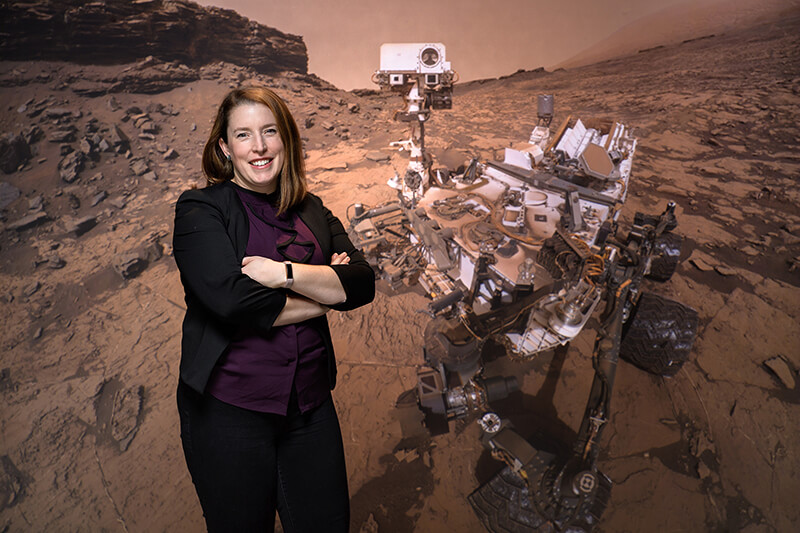September 26, 2018
Mars may provide our best glimpse into Earth’s beginnings. Meet the Purdue researcher exploring the Red Planet

Briony Horgan, a professor of earth, atmospheric and planetary sciences, searches Mars for clues about its early history, and ours. (Purdue University photo/John Underwood)
WEST LAFAYETTE, Ind. — One hundred forty million miles from Earth, cold winds whip dust harshly across the planet’s rocky surface. Clouds float through the thin atmosphere, and at night, two tiny moons shine in the sky. Though Mars looks like a desert now, many scientists believe water once flowed freely there, potentially fostering the development of microbial life.
Mars is one of the most habitable planets in our solar system, and it has more in common with Earth than you might think. This is why NASA’s been exploring the planet for more than 50 years – it’s a way to uncover the ancient history of life on Earth.
Briony Horgan, a professor of earth, atmospheric, and planetary sciences at Purdue University and scientist on NASA’s Curiosity and 2020 Mars rover missions, has spent much of her career trying to understand the history of the moon and Mars.
“We really want to know what Mars was like 4 billion years ago because that’s when it probably had liquid water, and it also would’ve been very similar to Earth at that time,” she said. “On Earth, the ancient terrestrial rocks have all been destroyed by plate tectonics and weathering – we don’t have access to anything that old. But on Mars, they’re just sitting at the surface waiting for us to go look at them.”
Minerals and rocks on Earth form under unique conditions, which means they can tell scientists about the different environments and climates they formed in. The same is true on Mars, where NASA has several rovers and orbiters looking for clues about the planet’s past climate and landscapes.
The Mars 2020 rover mission will explore regions that NASA thinks might have supported a watery environment where life could’ve thrived and left behind biosignatures. Ten to 15 years from now, they hope to bring samples collected on that mission back to Earth. Until then, NASA’s rovers and orbiters will rely on cameras that take detailed photos and chemical data of minerals and textures to determine where signs of life might be hidden.
“When rain falls on rocks, weathers them and turns them into soil, that creates certain kinds of minerals. We see those kinds of minerals on Mars, but there’s debate over whether they were created by rain, or snow or ice melting,” Horgan said. “Our work has shown that minerals that form in cold conditions are very distinct from those that form in long-term warm environments.”
The contentious debate about whether Mars was warm and wet or cold and icy in its early history has been dragging on since the 1980s. Horgan is trying to develop a new way to look at this issue - by investigating the minerals left behind by Mars-like features, there and on Earth.
Her team has been to places where water interacts with volcanoes all over the world, from Iceland to Hawaii. She recently returned from the Oregon Cascades, where her team studied whether glaciers leave behind chemical fingerprints in the rocks they erode and the sediments they create.
“We would like to use those fingerprints to understand the past extent of glaciers and ice sheets on Mars,” she said.
Horgan’s research group has traveled to Iceland to investigate rocks from subglacial volcanoes, with the goal of developing methods to detect that kind of environment on Mars. In 2019, she’ll return to the island to study how glacial and volcanic sediments are transported by wind and rivers.
“The common theme throughout our work is trying to understand how to identify different kinds of habitable watery environments in volcanic settings – from the relationship between the mineralogy of volcanic soils and the surface environment and climate they formed in, to hydrothermal activity created by interactions between volcanoes and water,” Horgan said. “In addition to figuring out what conditions on Mars were like billions of years ago, we’re uncovering a lot of really fundamental science about terrestrial geology.”
Writer: Kayla Zacharias, 765-494-9318, kzachar@purdue.edu
Sources: Briony Horgan, 765-496-2290, briony@purdue.edu

